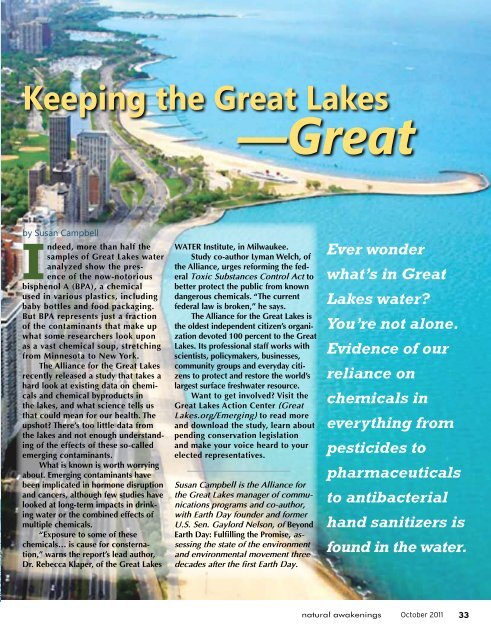STRAIGHTEN UP - Natural Awakenings
STRAIGHTEN UP - Natural Awakenings
STRAIGHTEN UP - Natural Awakenings
Create successful ePaper yourself
Turn your PDF publications into a flip-book with our unique Google optimized e-Paper software.
Keeping the Great Lakes<br />
by susan campbell<br />
Indeed, more than half the<br />
samples of Great Lakes water<br />
analyzed show the presence<br />
of the now-notorious<br />
bisphenol A (BPA), a chemical<br />
used in various plastics, including<br />
baby bottles and food packaging.<br />
But BPA represents just a fraction<br />
of the contaminants that make up<br />
what some researchers look upon<br />
as a vast chemical soup, stretching<br />
from Minnesota to New York.<br />
The Alliance for the Great Lakes<br />
recently released a study that takes a<br />
hard look at existing data on chemicals<br />
and chemical byproducts in<br />
the lakes, and what science tells us<br />
that could mean for our health. The<br />
upshot? There’s too little data from<br />
the lakes and not enough understanding<br />
of the effects of these so-called<br />
emerging contaminants.<br />
What is known is worth worrying<br />
about. Emerging contaminants have<br />
been implicated in hormone disruption<br />
and cancers, although few studies have<br />
looked at long-term impacts in drinking<br />
water or the combined effects of<br />
multiple chemicals.<br />
“Exposure to some of these<br />
chemicals… is cause for consternation,”<br />
warns the report’s lead author,<br />
Dr. Rebecca Klaper, of the Great Lakes<br />
—Great<br />
WATER Institute, in Milwaukee.<br />
Study co-author Lyman Welch, of<br />
the Alliance, urges reforming the federal<br />
Toxic Substances Control Act to<br />
better protect the public from known<br />
dangerous chemicals. “The current<br />
federal law is broken,” he says.<br />
The Alliance for the Great Lakes is<br />
the oldest independent citizen’s organization<br />
devoted 100 percent to the Great<br />
Lakes. Its professional staff works with<br />
scientists, policymakers, businesses,<br />
community groups and everyday citizens<br />
to protect and restore the world’s<br />
largest surface freshwater resource.<br />
Want to get involved? Visit the<br />
Great Lakes Action Center (Great<br />
Lakes.org/Emerging) to read more<br />
and download the study, learn about<br />
pending conservation legislation<br />
and make your voice heard to your<br />
elected representatives.<br />
Susan Campbell is the Alliance for<br />
the Great Lakes manager of communications<br />
programs and co-author,<br />
with Earth Day founder and former<br />
U.S. Sen. Gaylord Nelson, of Beyond<br />
Earth Day: Fulfilling the Promise, assessing<br />
the state of the environment<br />
and environmental movement three<br />
decades after the first Earth Day.<br />
Ever wonder<br />
what’s in Great<br />
Lakes water?<br />
You’re not alone.<br />
Evidence of our<br />
reliance on<br />
chemicals in<br />
everything from<br />
pesticides to<br />
pharmaceuticals<br />
to antibacterial<br />
hand sanitizers is<br />
found in the water.<br />
natural awakenings October 2011<br />
33





